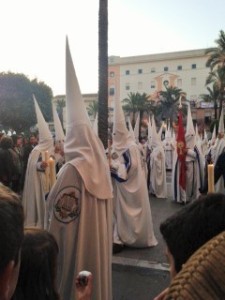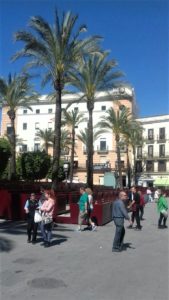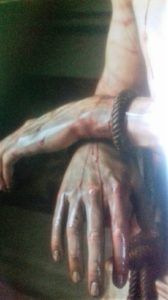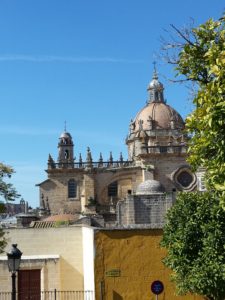 It was grey in London and, while I regretted leaving the newly sprung spring – the white blossom, the intense, new-minted green on the hedges – I was looking forward to warmth, sun and the scent of orange blossom. Here in Jerez there are currently all three, with temperatures up in the high twenties during the day.
It was grey in London and, while I regretted leaving the newly sprung spring – the white blossom, the intense, new-minted green on the hedges – I was looking forward to warmth, sun and the scent of orange blossom. Here in Jerez there are currently all three, with temperatures up in the high twenties during the day.
The whole town is celebrating Semana Santa – Holy Week – from  Saturday Sabado de Pasion, to Good Friday when the hermandades, the brotherhoods, belonging to the local churches, process through the streets of the town. The spectator stands are all over the centre of
Saturday Sabado de Pasion, to Good Friday when the hermandades, the brotherhoods, belonging to the local churches, process through the streets of the town. The spectator stands are all over the centre of
the city along the processional routes, some have been up for weeks. Traffic is disrupted during their construction, though during the Holy Week processions the centre of town is completely closed to traffic.
From the first evening of my arrival I have heard the practice sessions going on around town, although this time I didn’t come across any pasos – large floats – being carried round town at night at shoulder height bearing bricks, to prepare their bearers for the weight of the icons and statuary and allow them to practice manoeuvering their burden through the narrow twisting streets of the old town.
I have written before about the Easter penitential processions, marches of  bare-footed, hooded penitents, accompanied by musicians and choirs, following the icons and statues. These pieces often date back to the 1600s or even earlier, though some are modern, and all are in the tradition of sacred art in wood. London dwellers may recall the 2009 exhibition at the National Gallery, The Sacred Made Real, a celebration of Spanish religious sculpture in wood of the sixteenth and seventeenth centuries.
bare-footed, hooded penitents, accompanied by musicians and choirs, following the icons and statues. These pieces often date back to the 1600s or even earlier, though some are modern, and all are in the tradition of sacred art in wood. London dwellers may recall the 2009 exhibition at the National Gallery, The Sacred Made Real, a celebration of Spanish religious sculpture in wood of the sixteenth and seventeenth centuries.
The statues, often designed to be placed high up above congregations are,  nonetheless, astonishingly detailed. Musculature and veining are faithfully realised and remarkably lifelike. Some images in the Semana Santa processions are by known masters of the art, like the Ecco Homo by Jacome Baccaro (1757) which carried by El Mayor Dolor hermandad (the brotherhood itself dates back to 1488).
nonetheless, astonishingly detailed. Musculature and veining are faithfully realised and remarkably lifelike. Some images in the Semana Santa processions are by known masters of the art, like the Ecco Homo by Jacome Baccaro (1757) which carried by El Mayor Dolor hermandad (the brotherhood itself dates back to 1488).
This year, 2017, forty-four hermandades from churches and chapels across the city will process through the streets, following their own specific routes,  but all taking in the Cathedral. The processions include between twenty and fifty penitents and nearly all are accompanied by bands, often belonging to the church, but also sometimes from towns and villages in the countryside surrounding Jerez. The brotherhoods (there are no sisterhoods, this is the Catholic Church) are often very old and all have their own costumes – robes and pointed hoods – sometimes sombre and black sometimes in brighter colours.
but all taking in the Cathedral. The processions include between twenty and fifty penitents and nearly all are accompanied by bands, often belonging to the church, but also sometimes from towns and villages in the countryside surrounding Jerez. The brotherhoods (there are no sisterhoods, this is the Catholic Church) are often very old and all have their own costumes – robes and pointed hoods – sometimes sombre and black sometimes in brighter colours.
The centre of town is packed with spectators every afternoon and evening. On Good Friday the processions begin at 1.30 in the morning and continue until 11, then resume again at four in the afternoon until the early hours. This is the longest day.
Having a home along one of the processional routes is considered a selling point, as it means having an excellent view as the processions pass.  Needless to say the narrow street on which my building is located is on the route of only one, local, church, but several journey along Medina, the larger road into which mine runs. Nonetheless it is possible, when sitting on my terrace, to hear the often dirge like processional music from all over the city. One couple I know, whose apartment lies on the route of almost all the processions, go away for Semana Santa rather than have the constant noise and the difficulties posed by the crowds. It’s not for everyone, I guess.
Needless to say the narrow street on which my building is located is on the route of only one, local, church, but several journey along Medina, the larger road into which mine runs. Nonetheless it is possible, when sitting on my terrace, to hear the often dirge like processional music from all over the city. One couple I know, whose apartment lies on the route of almost all the processions, go away for Semana Santa rather than have the constant noise and the difficulties posed by the crowds. It’s not for everyone, I guess.
By the time Good Friday arrives I will be back in London. the Anglican church local to me in Clapham, the Church of the Holy Spirit, will conduct its own small procession of the stations of the cross around Abbeville Road, but with nothing like the panoply of its Jerez counterparts and with far fewer followers.
If you enjoyed reading this article you might also enjoy Vendimia Vendimia II Andalucian Spring; The Feria Jerez in the Rain Cadiz in the Rain Zambomba


 RSS – Posts
RSS – Posts